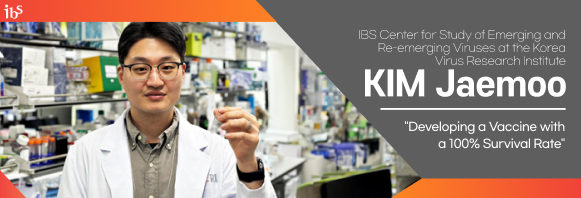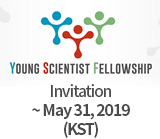주메뉴
- About IBS 연구원소개
-
Research Centers
연구단소개
- Research Outcomes
- Mathematics
- Physics
- Center for Underground Physics
- Center for Theoretical Physics of the Universe (Particle Theory and Cosmology Group)
- Center for Theoretical Physics of the Universe (Cosmology, Gravity and Astroparticle Physics Group)
- Dark Matter Axion Group
- Center for Artificial Low Dimensional Electronic Systems
- Center for Theoretical Physics of Complex Systems
- Center for Quantum Nanoscience
- Center for Exotic Nuclear Studies
- Center for Van der Waals Quantum Solids
- Center for Relativistic Laser Science
- Chemistry
- Life Sciences
- Earth Science
- Interdisciplinary
- Center for Neuroscience Imaging Research (Neuro Technology Group)
- Center for Neuroscience Imaging Research (Cognitive and Computational Neuroscience Group)
- Center for Algorithmic and Robotized Synthesis
- Center for Genome Engineering
- Center for Nanomedicine
- Center for Biomolecular and Cellular Structure
- Center for 2D Quantum Heterostructures
- Center for Quantum Conversion Research
- Institutes
- Korea Virus Research Institute
- News Center 뉴스 센터
- Career 인재초빙
- Living in Korea IBS School-UST
- IBS School 윤리경영


주메뉴
- About IBS
-
Research Centers
- Research Outcomes
- Mathematics
- Physics
- Center for Underground Physics
- Center for Theoretical Physics of the Universe (Particle Theory and Cosmology Group)
- Center for Theoretical Physics of the Universe (Cosmology, Gravity and Astroparticle Physics Group)
- Dark Matter Axion Group
- Center for Artificial Low Dimensional Electronic Systems
- Center for Theoretical Physics of Complex Systems
- Center for Quantum Nanoscience
- Center for Exotic Nuclear Studies
- Center for Van der Waals Quantum Solids
- Center for Relativistic Laser Science
- Chemistry
- Life Sciences
- Earth Science
- Interdisciplinary
- Center for Neuroscience Imaging Research (Neuro Technology Group)
- Center for Neuroscience Imaging Research (Cognitive and Computational Neuroscience Group)
- Center for Algorithmic and Robotized Synthesis
- Center for Genome Engineering
- Center for Nanomedicine
- Center for Biomolecular and Cellular Structure
- Center for 2D Quantum Heterostructures
- Center for Quantum Conversion Research
- Institutes
- Korea Virus Research Institute
- News Center
- Career
- Living in Korea
- IBS School
News Center
| Title | "Developing a Vaccine with a 100% Survival Rate" | ||||
|---|---|---|---|---|---|
| Name | 전체관리자 | Registration Date | 2025-06-19 | Hits | 142 |
| att. |
 ibs people.png
ibs people.png
|
||||
"Developing a Vaccine with a 100% Survival Rate"
Recently, as COVID-19 Omicron variant-related deaths have surged in Hong Kong, the importance of vaccine response systems in pandemic preparedness is once again under the spotlight. In this context, the Center for Study of Emerging and Re-emerging Viruses at the Korea Virus Research Institute, part of the Institute for Basic Science (IBS), has drawn attention by verifying the long-term immune effects of a next-generation vaccine platform called KE-VAC, offering a new strategic direction for vaccines. Dr. KIM Jaemoo, the postdoctoral researcher who led the study, confirmed that KE-VAC demonstrated exceptional immune capabilities not only against COVID-19 variants but also against influenza and severe fever with thrombocytopenia syndrome (SFTS). KE-VAC works by releasing the vaccine gradually over a long period inside the body, mimicking natural infection to stimulate the immune system in a sustained way and thereby prolonging vaccine efficacy. In this study, Dr. Kim administered KE-VAC to animal models infected with high-risk pathogens and conducted a detailed analysis of the long-term neutralizing antibody responses and antigen-specific activation of T and B cells. The experiment showed that animal models vaccinated with KE-VAC maintained antibodies for over 18 weeks, and under SFTS virus conditions, achieved a 100% survival rate. This outcome is considered a breakthrough, as it overcomes the limitations of existing mRNA vaccines, particularly in terms of durable immune response and protection against variant viruses. Dr. Kim commented, “This research result is highly meaningful as a vaccine adjuvant that could respond to various viruses that may emerge in the future,” adding, “I hope to further study viral infection immunity to develop vaccines that elicit the body's optimal response.” The following is a Q&A with Dr. Kim. Q. Please introduce yourself. Hello. I’m KIM Jaemoo, a postdoctoral researcher studying immunology at the Center for Study of Emerging and Re-emerging Viruses, Korea Virus Research Institute, Institute for Basic Science (IBS). I've been interested in immunity and vaccines since high school, which naturally led me to major in biotechnology as an undergraduate. I continued my studies in graduate school and, after earning my Ph.D., joined the research team of Dr. Young Ki Choi, Director of the Korea Virus Research Institute at IBS. Q. It’s quite unique that you were interested in immunology from a young age. I developed a natural interest in it during high school because I enjoyed studying biology. As an undergraduate, I began studying immunology in earnest and was fascinated by how our immune system distinguishes between ‘self’ and ‘non-self’ to defend the body against foreign invaders. What intrigued me most was that immune responses are both complex and, at the same time, operate under surprisingly simple and consistent principles. I chose to focus on vaccine research in particular because, no matter how advanced science and technology become, viruses can never be completely eradicated — so it’s crucial to be prepared for future infectious diseases in advance. Q. What kind of place is the Center for Study of Emerging and Re-emerging Viruses? As the name suggests, the Center for Study of Emerging and Re-emerging Viruses conducts fundamental research on viruses. We investigate the characteristics of highly mutable viruses like COVID-19 and other potential future pathogens, analyze their pathogenic mechanisms, and play a key role in the development of therapeutics and vaccines. In particular, our facility is equipped with an Animal Biosafety Level 3 (ABSL-3) laboratory, which allows us to safely study high-risk pathogens and viruses. This infrastructure also supports research conducted by other institutions and universities, making a broad contribution to the scientific community. Q. How has virus research changed since the COVID-19 pandemic? Interest in viruses and vaccines surged during the peak of the COVID-19 pandemic, but that urgency has gradually faded over time. However, from a researcher’s perspective, the risk of new viral outbreaks remains high due to ongoing environmental changes. Viruses not currently found in Korea — such as dengue, chikungunya, or Zika — could potentially emerge here. It’s essential that we prepare in advance for these threats. Q. What are the key features of the KE-VAC vaccine research? KE-VAC is a next-generation vaccine platform designed to stimulate the immune system in a way that mimics natural infection. It builds upon a cancer vaccine adjuvant developed by Professor LIM Yong Taek’s team at Sungkyunkwan University, which targets the TLR7/8 pathway. The vaccine has two main features: “kinetic engineering” to sustain immune responses over time, and prolonged antigen exposure using alum (aluminum-based compounds). In simpler terms, the vaccine components are released gradually in the body, allowing the immune effect to last much longer. We decided to apply this technology to virus vaccines — and the results exceeded expectations. KE-VAC showed promising performance not only against COVID-19, but also against other high-risk viruses like influenza and SFTS (Severe Fever with Thrombocytopenia Syndrome). Q. How is this vaccine different from traditional vaccines? When a vaccine is injected, dendritic cells near the injection site detect the foreign antigen and initiate the immune response. These cells recognize the vaccine components as intruders, engulf them through phagocytosis, and then migrate to the lymph nodes. There, they present the antigen to T cells and B cells, triggering a specific immune response. Some of these activated cells become memory cells, forming long-term immunity. A good vaccine ensures that this immune memory lasts for a long time. However, when a vaccine is injected in liquid form, it tends to spread and dilute quickly within the body, limiting how long it can effectively stimulate the immune system. For example, mRNA vaccines are advantageous for mass production, but their immune protection typically lasts only about 6 months to a year. Q. What is the technological mechanism behind KE-VAC’s slow-release function? KE-VAC forms nanoparticles by combining the vaccine antigen with alum and a TLR7/8 receptor agonist. Nanoparticles enhance immune cell recognition and responsiveness. Alum, which has a sticky and viscous consistency, slowly dissolves in the body, gradually releasing the embedded adjuvant and antigen over an extended period. The nanoparticles are also engineered to mimic the size of viruses or bacteria, making them more easily recognized by immune cells. As a result, the body continues to "remember" the threat, sustaining a strong and lasting antiviral effect. Q. How was KE-VAC’s actual effectiveness demonstrated? In animal experiments, KE-VAC showed outstanding protection against several high-risk viruses. It produced strong results against variant strains of COVID-19 as well as multiple influenza subtypes. Most notably, in tests targeting SFTS (Severe Fever with Thrombocytopenia Syndrome), antibodies persisted for 18 weeks, and the infected subjects achieved a 100% survival rate. Further analysis revealed heightened activation of antigen-specific memory T cells and B cells. When a human-use vaccine was administered using KE-VAC, the immune response was significantly enhanced, leading to very high survival outcomes. Q. What is the significance of developing KE-VAC? When mRNA vaccines emerged during the COVID-19 pandemic, they were expected to replace traditional vaccine technologies. However, in terms of actual effectiveness, conventional vaccines were found to be superior. While mRNA vaccines are advantageous for rapid mass production, they have limitations—such as relatively short-lasting immunity and weaker protection against viral variants. KE-VAC addresses these shortcomings with its long-lasting immune response and adaptability. By complementing the weaknesses of mRNA vaccines, KE-VAC is expected to significantly strengthen humanity’s ability to respond to infectious diseases and help prevent large-scale outbreaks like those of the past. Interestingly, I served in the military as part of the chemical unit, so I had countless experiences wearing protective gear. I sometimes feel like I have a strange fate of always ending up suited in something. Q. Any memorable episodes during your research? In the ABSL-3 facility, where we handle high-risk viruses, we have to wear full protective gear with no gaps. It gets extremely uncomfortable, and once you begin an experiment, you usually have to stay suited up for 4 to 5 hours straight. So I often found myself torn between urgent biological needs and completing the experiment. (laughs) Q. What kind of research do you want to pursue in the future? In the past, I was mainly interested in vaccine development and efficacy testing, but through my work at the institute, I’ve become deeply fascinated by infection immunity. I’m now particularly interested in researching immune responses to viral infections and applying those findings directly to vaccine development. I believe that if we can design vaccines based on the unique immune responses triggered by different viruses, we can create much more efficient solutions. Ultimately, I want to develop vaccines that guide the immune system to respond in the most optimized way to defend against viruses. |
|||||
| before |
|---|
- Content Manager
- Public Relations Team : Yim Ji Yeob 042-878-8173
- Last Update 2023-11-28 14:20












